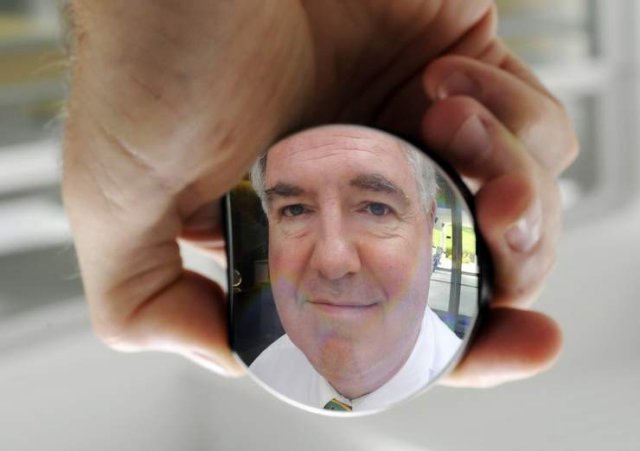 Headwall Photonics in Fitchburg, Massachusetts, specializes in spectral imaging. The sensors it makes can detect — very sharply and from great distance — light wavelength patterns that are imperceptible to the human eye.
Headwall Photonics in Fitchburg, Massachusetts, specializes in spectral imaging. The sensors it makes can detect — very sharply and from great distance — light wavelength patterns that are imperceptible to the human eye.
The company’s technology has military and government intelligence applications. For example, they are part of reconnaissance satellites that can see from 65,000 feet up and hand-held battlefield sensors that can clearly distinguish a camouflaged enemy a kilometer away.
Yet demand for Headwall’s products is increasing from commercial customers, according to Christopher Van Veen, who handles marketing for the company.
For example, a hyperspectral imaging sensor placed in a Cessna and flown over agricultural land can gauge irrigation patterns, detect disease in plants, or identify by a spectral or chemical “fingerprint” prime acreage for planting certain crops, Mr. Van Veen said.
The University of Tasmania last year flew one of the company’s sensors in an unmanned “octo-copter” over Antarctica to study environmental conditions there, he said. Another client uses Headwall sensors in a food-packaging plant to spot stems or foreign objects in berries on a conveyor belt.
Other applications for their sensor technology include microscopic analysis of tissue and cells, the age-dating of art or documents in museums, and even choosing the right paint color at the hardware store, Mr. Van Veen said.
“Someone is inspecting something somewhere and they need a better set of eyes,” he said. “This represents a better set of eyes.
“Because we’re able to make these instruments rapidly, affordably, and easier to use, commercial endeavors say, ‘This is pretty good for us. If it was good for the Air Force and their U2 spy-planes, we can put this to good use, too.’?”
The business, which employs 40 people, is the world’s largest manufacturer of a particular kind of optical component — called a diffraction grating — used in these sensors.
“Because we’re able to make these gratings small” — the size of a thumbnail, in some cases — “it’s feeding a whole new industry of small handheld devices,” said Mr. Van Veen. The company’s products are also used in unmanned aerial vehicles, or drones, because the sensors are “smaller, lighter and less power-hungry.”
Headwall built its business on what are called diffraction or holographic “gratings” — key components of hyperspectral sensors. These optical components are called gratings because they are grooved with lines off which light bounces, or diffracts.
At a glance, the diffraction gratings resemble compacts, or pill boxes, coated in gold substrate.
“They come big, they come small, they come convex and concave,” Mr. Van Veen said, showing a visitor a selection of the components, of different sizes, each grooved imperceptibly with precise lines that diffract light. When he moved one, a little rainbow was visible on its surface.
Holographic diffraction gratings have been instrumental in telecommunications, since optical networking involves managing light, he said. Now these core bits of light-diffracting technology, precision-tooled, are being put to applications in agriculture, food inspection and non-invasive medicine, as well as military reconnaissance and homeland security, he said.
Sensors outfitted with these optical components can be programmed to recognize the “spectral fingerprints” of everything — animal, vegetable or mineral.
Hung from a plane or suspended over a conveyor belt, “these sensors are like silent sentinels,” Mr. Van Veen said. “They look down and say, good, bad, good, bad. They know this based on algorithms: You’ve told the sensor what to look for, within certain spectral bands.”
Thus spectral imaging can be used to validate the dating of artwork in a museum or detect traces of drugs or explosives at a security checkpoint.
“All have their known spectral fingerprints,” he said. “You can tell the sensor to look for them.”
Headwall makes diffraction gratings that are grooved to customers’ precise specifications. The company also makes the larger sensors themselves. “Everything you see in a hyperspectral sensor is a by-product of what is made here,” Mr. Van Veen said.
While Mr. Van Veen would not discuss the company’s annual revenues, he said Headwall has clients worldwide, with roughly half its business in the government and military sector and half in the commercial arena.
“The commercialization of this technology has just been amazing, because decades ago hyperspectral imaging was the province of the military — it was dark stuff, it was secretive stuff, no one really talked about it,” he said. “You knew it was up there, you knew what they were doing and looking for, but no one really paid attention to how they were doing it, until companies like ours said there’s a way to commercialize this, and take this technology and do good work with it.”
Photo: Christopher Van Veen, head of marketing for Headwall Photonics in Fitchburg, is reflected in a holographic diffraction grating he is holding. The gratings are grooved with lines off which light bounces, or diffracts, and are the key optical components used in hyperspectral sensors. (Image was flipped by photographer; otherwise, the mirror image is naturally upside down.) (T&G Staff /RICK CINCLAIR)
Source: News Telegram
